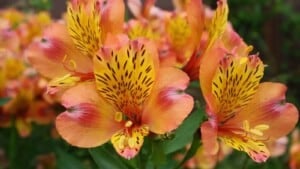According to the Environmental Protection Agency, 30% to 70% of the water consumed by America’s residential homes is used outdoors. Summertime lawn and garden watering can multiply household water use two to four times (PDF) over what is used the rest of the year.
The shocker: half the water used outdoors is wasted.
While the EPA’s website on outdoor water use is promoting their “Water Sense” certification of approved products — and using the highest quality, water-wise products can make a difference — much of water conservation comes from the design of your landscape, especially the plants you choose to grow, and the ways water is applied to that landscape. Gone are the days in which we set the oscillating sprinkler out after lunch and let it run all afternoon.
Many places in the country enforce water restrictions and outright watering bans during summer. And the monthly cost of water, especially when you’re increasing your usage by even 30%, let alone 70%, is nothing to scoff at, no matter where you live.

A BESTSELLER!
Bordy Plant Waterer
Going on vacation? The Scheurich Bordy will watch after your plants for 4 days.
Learn moreGoing on vacation? Simply fill the Bordy Automatic Waterer and rest assured that your plants will be perfectly watered for up to four days. Select from FOUR assorted (and stylish!) colors: orange, blue, green and clear.
Here are some ways you can cut your outdoor water usage this summer. No doubt, many of us are already employing some of these recommendations.
Home Gardens
- Never run sprinklers to water your garden. Sure, it’s easy to set the sprinkler to cover the entire garden and let it go. But much of the sprinkler water is lost to the breeze and evaporation. And different plants require different amounts of watering. We don’t want to over water one plant while we’re under watering another.
- Hose and nozzle watering can also be wasteful. Keep spray or shower directed to each particular plant and use a trigger nozzle that allows use to quickly turn off water as you move between plants and rows. Nozzles with multiple settings and an on-off trigger are best, allowing you to adjust spray and pressure to avoid run-off or plant damage.
- Hand-water small gardens (or specific plants) with a watering can. For those with the back and shoulders to hoist one, a watering can is perfect for applying water directly around the plant where it’s most needed.
- Many garden vegetables and some bedding plants are best watered near the soil, keeping moisture off leaves, stems, and blossoms where it may encourage fungus and other diseases as well as attract insects. If you have insects on your leaves, blasting them off with a spray of water can be wasteful where water is at a premium. Instead, hand-pick (or squash eggs and larvae right where you find them) and release beneficial insects. Or you can spray bug-hosting plants with OMRI certified pesticides.
- Employ soaker hoses, drip irrigation, and other conservation-minded forms of garden irrigation as practical. If your watering system is on an automatic timer, make sure you use a rain or soil moisture detector to keep it from running when not needed. Otherwise, control your system manually, watering only when needed.
- Mulch between plants and rows to slow evaporation from the soil. Thin plants to recommended spacing distance to avoid competition for soil moisture.
Yards and Lawns
- We’ve advocated for replacing lawns with water-smart plants including thyme. In some dry and drought stricken regions, a lawn sucks down way too much water to make it practical (and affordable). (Full disclosure: we have patches of clipped fescue in our landscape…for the kids and the dog, natch.)
- Know that lawns go dormant naturally during some part of the summer. It doesn’t hurt them to go dormant (though they’re more vulnerable to foot traffic) and you don’t have to water them during this time. If you’re watering your lawn during this period to keep it green, consider calculate how much it’s costing you.
- Aerating your lawn in the spring will help your lawn maintain moisture through the warmer months. Aerating again in the fall helps maintain that retention, besides have other benefits for your turf.
- Set your mower higher. Leave at least three inches of grass, three-and-a-half for fescue, after each mowing. The added height shades the ground, slowing evaporation. Mowing shorter not only provides less protection for the soil, it allows quicker uptakes of water into the atmosphere.
- Take the clippings bag off your mower and allow the cut grass to settle back into the yard. Think of these clippings as a kind of mulch that helps hold soil moisture in the ground. The decaying grass also encourages beneficial microbes that will help keep your turf healthy.
- Heavily fertilized lawns require more water. If you must fertilize, do so in the fall. Or spread compost on your turf. It will improves the soil’s water holding ability while providing nutrition to your grass.
- The University of Nebraska Extension Lancaster County division has a worthy article on dealing with lawns during drought. If you live in an area where drought is ongoing and water scarce, consider getting rid of it and installing native plants that will use less water. One word: Xeriscape.

Planning and Design
- Contrast and compare your monthly water bills to see how use has changed from winter to summer. Keep this information in your gardening journal where it can easily be compared to the records you’ve kept on weather conditions. These kinds of records, especially when kept year-to-year, will help you measure the success of your water conservation efforts.
- Consider spot or spray irrigation for specific plantings in your landscape. If using automatic irrigation, install controllers that turn off automatic irrigation during rainy periods.
- Make sure your hoses are in good, no-leaks repair and that any connection made between hoses, nozzles or other devices is tight. Hose should be tightly secured to faucets. Faucets, including those attached to your home, should be regularly inspected for leaks. A sealed faucet not only saves water but helps protect your home’s foundation.
- Design your landscape using “rain garden” principles designed to hold and channel rainfall to where it’s needed. Consider harvesting rain fall in rain barrels for future use.
- Oregon State University Extension Service’s Water-Wise Gardening (PDF) resources cover specific plants and conditions when planning your landscape. Take advantage.











